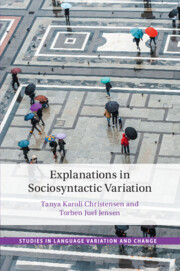Book contents
- Explanations in Sociosyntactic Variation
- Studies in Language Variation and Change
- Explanations in Sociosyntactic Variation
- Copyright page
- Contents
- Figures
- Tables
- Contributors
- Series Editor’s Preface
- Acknowledgements
- Introduction: Analysing and Explaining Syntactic Variation
- 1 Comparing Syntactic Variables
- 2 Mapping Syntax and the Sociolinguistic Monitor
- 3 A Columbia School Perspective on Explanation in Morphosyntactic Variation
- 4 On the Inevitability of Social Meaning and Ideology in Accounts of Syntactic Change: Evidence from Pronoun Competition in Netherlandic Dutch
- 5 The Predictability of Social Stratification of Syntactic Variants
- 6 When Variants Lack Semantic Equivalence: Adverbial Subclause Word Order
- Index
- References
3 - A Columbia School Perspective on Explanation in Morphosyntactic Variation
Published online by Cambridge University Press: 06 January 2022
- Explanations in Sociosyntactic Variation
- Studies in Language Variation and Change
- Explanations in Sociosyntactic Variation
- Copyright page
- Contents
- Figures
- Tables
- Contributors
- Series Editor’s Preface
- Acknowledgements
- Introduction: Analysing and Explaining Syntactic Variation
- 1 Comparing Syntactic Variables
- 2 Mapping Syntax and the Sociolinguistic Monitor
- 3 A Columbia School Perspective on Explanation in Morphosyntactic Variation
- 4 On the Inevitability of Social Meaning and Ideology in Accounts of Syntactic Change: Evidence from Pronoun Competition in Netherlandic Dutch
- 5 The Predictability of Social Stratification of Syntactic Variants
- 6 When Variants Lack Semantic Equivalence: Adverbial Subclause Word Order
- Index
- References
Summary
Two approaches to developing a theoretical platform for the study of sociosyntax are compared. The first approach adopts a sentence-based theory of syntax and an objectivist theory of semantics, which serves to qualify forms as variants of a sociolinguistic variable. The second approach replaces the sentence with the sign (signaled by grammatical formatives and word-order patterns) as the primary organizing principle of grammar and the basic carrier of meaning. It also replaces objectivist semantics with subjectivist-construal, functional-semiotic semantics under which grammatical meanings offer particular speaker perspectives. In this second approach the alternants of interest to sociolinguists are in almost every case different in their component meanings, yet amenable to conceptualization as variants of a sociolinguistic variable. Variation is seen as resulting from pressures exerted simultaneously by the exigencies of communication and the force of both internal and external sociolinguistic factors. This approach offers considerable advantages for the study of sociosyntax, advantages that pertain to both overall theoretical coherence and clearer paths to the explanation of the effects of predictor variables. We illustrate these advantages with analyses that demonstrate the impact of switch-reference on the presence and absence of Spanish yo, tú, ella, él, etc. ('I, you, she, he').
Keywords
- Type
- Chapter
- Information
- Explanations in Sociosyntactic Variation , pp. 90 - 119Publisher: Cambridge University PressPrint publication year: 2022

